Turn back the pages with a click
View(s):As the country readies to celebrate Independence Day on February 4, Adilah Ismail talks to the movers behind archiving a pictorial history of our land on social media
A faded sepia- tinted picture dated in the 1890s depicts camels transporting crates of Lipton’s Ceylon Tea in front of the pyramids in Egypt. More close to home a battered photograph shows Nugegoda, positively unrecognisable in its old avatar, with uncluttered roads and shops adorned with hand painted typographic signs. The 1949 programme for the first anniversary of Sri Lanka’s independence is a simple one devoid of trappings, and highlights that the National Song should be sung in Sinhala and Tamil to inaugurate the Independence Memorial Building at Independence Square.A poster for Coca Cola in 1993 elicits a flood of delighted nostalgia on Facebook about a yo-yo promotion conducted during that year. A 1910 photograph portrays a solemn, stilted studio photograph typical of the past – four austere young girls, with hair combed down with oil and faces that contain hidden stories.
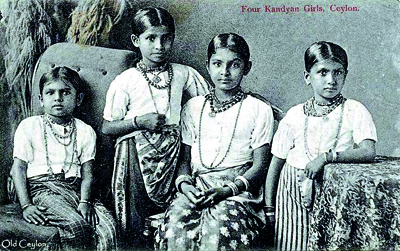
From ‘Old Ceylon’ : Four Kandyan girls (1900-1910)
With Independence Day beckoning, it seems only natural to traipse through Sri Lanka’s past and reminisce. Of late it seems that history lovers have ventured where formal institutions in Sri Lanka have been reluctant to tread. The recent years have seen a surge in the digitisation of history and cultural memory, particularly on social media. These pictures of decades gone by effortlessly cut through the visual clutter of selfies, cat videos, political updates, more selfies and aesthetically arranged plates of food which usually pepper social media timelines, providing truncated pieces of the past.
Meanwhile in another cornerof the internet, is a picture of Gregory Peck looking slightly out of place at the Gadaladeniya Temple in Pilimathalawa during a shoot for the film ‘The Purple Plain’. A deceptively cheerful war poster urges recruitment for the army with the slogan “We feed you – we clothe you – we make a new man of you!” while a younger Rosy Senanayake espouses the benefits of Pandol in a 1987 monochrome advertisement in the Lanka Woman.

Nishan Magodaratna: The man behind ‘The Archives’
While it’s remarkably compelling – even if for just a moment – to mentally step into a portal to the past, curated communities such as these serve a larger purpose. Why, at a time where there’s an inundation of information, are efforts like these important? There’s a Julian Barnes quote which seems apt for the occasion –‘History is that certainty produced at the point where the imperfections of memory meet the inadequacies of documentation.’ Provided, they are absorbed with thought and prudence (as with everything else on the internet), digital communities and communal archiving can help counter these foibles of history. They break free from the confines of physical spaces and rupture inaccessibility, exploring the possibilities of multiple narratives while encouraging discussion and fostering democratic partnerships.
The popular Facebook page, Old Ceylon, is perhaps one of the main forerunners among those who have proactively taken steps to archive Sri Lanka’s past on social media and the main vein for communal archives. Usually turning down advances from TV and the papers, the reclusive administrators of the Facebook page insisted that they do not seek any personal publicity for themselves and provided a glimpse of how their page evolved to the Sunday Times.Old Ceylon initially began as a website but soon turned to Facebook as its primary platform after its creator, who was a founding member of Mark Zuckerberg’s Development Team, realised Facebook’s enormous potential during its formative years.

From ‘The Archives’: Gregory Peck at Gadaladeniya Temple shooting the 1954 film, ‘The Purple Plain’
Unfortunately a tripartite combination of war, fire and flood ensured that a majority of the creator’s personal collection was wiped out. Therefore the initial content posted on the Old Ceylon page were sourced from its remnants and then with the help of family and friends’ memorabilia.“During the past 30 years, much of what I loved was eroded and I decided to try and preserve my and other people’s happy memories,” explains the founder of the page, simply. Gradually, others joined in and the page now thrives on colourful crowd sourced content,rescuing a mosaic of memories from the confines of the private space onto a public sphere. “Private family photos, memories which otherwise would never be shared or displayed in any normal museum – Here, on our page we show them and they are admired and preserved for ever. That is what the strength of Facebook is: We interconnect common people,” say the page’s administrators. “We’ve turned down many invites for exhibitions and TV presentations. Facebook is ideal. It’s free and accessible to all and plus, it’s fully interactive.”
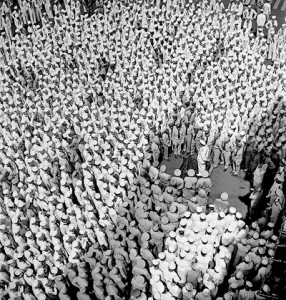
From ‘The Archives’: British Admiral Lord Louis Mountbatten speaking to the officers and men of USS Saratoga in Trincomalee, April 1944
Old Ceylon, in its present form, has been active since 2009 and amassed over 100,000 ‘likes’. The board of administrators for the page expanded over the years and are now scattered across Arugam Bay, Colombo, Kabul and Cardiff and bound together by a love for the island’s history and fuelled by a need to record the past.
Old Ceylon is careful not to blindly fall into the saccharine trap of romanticising the past with rose-tinted glasses. Instead the page dips into a historical wellspring of the good, bad, great and sordid – ranging from evidence of animal cruelty and colonial mishaps to old advertisements, lithographs and paintings prompting debates, arguments, ruminations and commentary from its base of users. “We post anything of possible interest,” they explain, “We love to leave the images or posts to the reactions of our readers without our own opinion being aired […] everything we post is free, is in the public domain and can be used, reproduced and published anywhere.”
*************************
On the 1st of November 1984, 12-year- old Nishan Magodaratna took a detour before going to school. It was the day after Indira Gandhi’s assassination and he went to the market and brought back all the day’s newspapers with stern instructions to the household not to touch them. This marked the beginning of a 30-year journey. Whenever anything of importance happened, he would save copies of the newspapers and articles and bolstered by papers that his brother collected and reference material from his father, who was a government servant, his collection gradually grew.
Nishan’s Facebook page ‘The Archives’ is a fairly new entrant to the social mediasphere but is slowly gaining a following. He describes the page as a “History classroom – in a more consumable way”. “Our recent and contemporary history has not been digitized. While more recent nations have realms and realms of stuff available online, you don’t get anything substantial online for Sri Lanka,” laments Nishan. The page was started to counter the dearth of contemporary Sri Lankan history documented on the world wide web, share anecdotes about the country’s past with likeminded people and counter the destructive tendencies of termites ( Nishan ruefully acknowledges that steel cabinets might be a preferred option instead of wood for future storage purposes).
The page began on the eve of the 50th anniversary of JFK’s assassination in November 2013, with little known pictures featuring John and Jacqueline Kennedy with Sri Lanka’s first Governor General, William Gopallawa appropriately as its first post. “Social media is one of those platforms where already there is a congregation to pull attention,” explains Nishan adding that the recent surge in interest has prompted him to explore Twitter and Pinterest as accompanying mediums.
Inspired by storytellers such as Richard Boyle and Gamini G. Punchihewa, The Archives fashions itself as a digital raconteur through capsule-sized history lessons and anecdotes accompanying its posts. Although starting off purely with newspaper clippings and photographs, the Facebook page also posts extracts from books, paintings, posters and other memorabilia related to Sri Lanka’s contemporary history and welcomes discussion, clarifications and debate from its commentators.
Nishan tries to provide a timely relevance to the page through its material. For instance, posting pictures of a young Che Guevera’s visit to Ceylon on the anniversary of the date or posting old scans of relevant newspaper headlines during the run-up to elections. He remains grateful to Earl Bumotad (who came up with the name), Shanaka Rathnayake, Aravindhan and his wife for their support and notes that it would be great if Sri Lankan institutions such as the Government Film Unit took steps to make available the veritable wealth of archives and reels more accessible to the public. “Sri Lanka has been going places and as a nation we are not aware of these situations, events and circumstances,” muses Nishan, “I feel that by getting to know more about this we become more positive, more optimistic and have more pride as a country and as a nation”.
Where to go on the net
Old Ceylon’s Facebook page can
be accessed on https://www.facebook.
com/OldeCeylon while The
Archives can be found at https://
www.facebook.com/thearchivesl
For an added dose of nostalgia
before Independence Day, City
Guide Yamu.lk has compiled an
interactive series of before and
after shots of locations in Colombo:
https://www.yamu.lk/colombothen-
now/
The old face of Independence Day
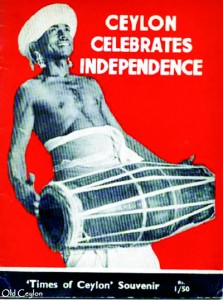
From ‘Old Ceylon’: The souvenir issued by the Times of Ceylon to mark the first anniversary of Independence
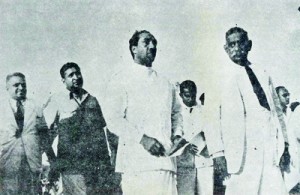
From ‘The Archives’: First Prime Minister of Independent Ceylon D.S Senanayake with J.R. Jayewardene and Dudley Senanayake at the Independence Day celebration in 1950
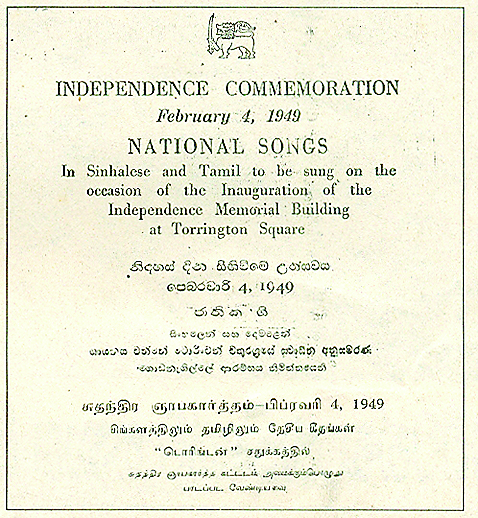
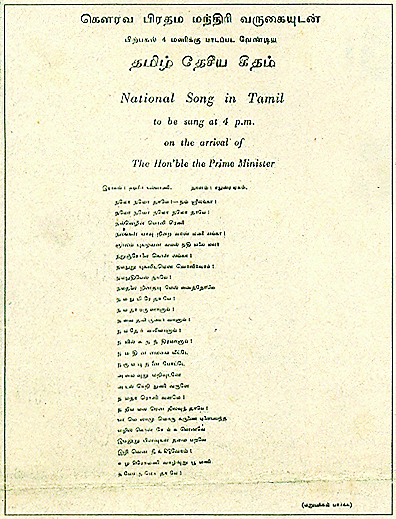
From ‘The Archives’: First anniversary of Independence: The programme and the National Anthem in Tamil in the programme


